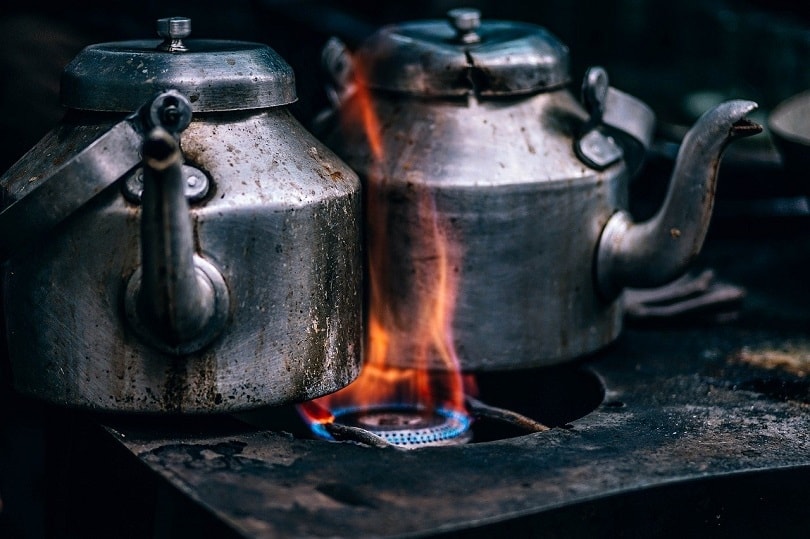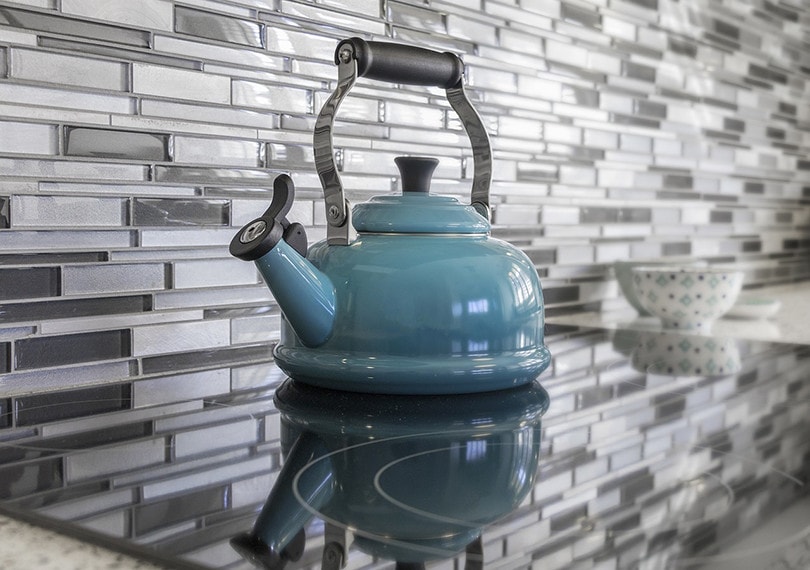Who Invented the Kettle & When? (History of the Kettle)
-
Pete Ortiz
- Last updated:

A kettle is a common appliance in most kitchens, but have you ever wondered how long it has crucially served humankind? Well, it has an exciting history that sparked from the massive revolutionary human activity in Mesopotamia in 3500 BC that oversaw many other famous inventions.
By comparison, the modern kettle is far more advanced than the early forms of kettles, considering that we can now quickly warm our pots of tea with a flick of the switch. However, no evidence exists to approve whether the early inhabitants of the world used the first kettle inventions to boil water or tea.
The remainder of this article will dig deeper into the history of the kettle and the transformations it has undergone from the Neolithic Age to what you have on your kitchen shelf. Enjoy!
The History of the Kettle
Early Forms of the Kettle (3500 BC – 18th Century)
Archaeologists discovered the very earliest vessel for heating water in Mesopotamia. It dates back to as early as 3500 BC and was made from bronze, an alloy of tin and copper (the first metal alloy created by man).
Because they were metallic, these early kettle forms were solid and durable. They could endure the knocks and bashes encountered from constant use and frequent transportation. It was an essential life tool for early man, initially preserved for cooking food before evolving into tea kettles.
It’s important to note that the Neolithic Age kettle took various forms and shapes in different regions. The stylish Russian samovar, made from ancient metals, is believed to trace its roots to Persia. However, all the first forms of kettles were physically typical—they had an open top and were placed over a flame. This trend continued until the 19th Century when newer technology was introduced into the kettle market.
The First Electric Kettles (19th and 20th Centuries)
It wasn’t until the last two centuries that the drudgery of heating water shifted for the better. In 1891, an American firm called the Carpenter Electric Association of Chicago enlisted the first electric kettle in their catalog. This meant you’d no longer need an open fire to warm tea or boil water, but rather a power source. The kettle featured a heating element that was quite primitive when compared to modern models.
The major setback of the first electric kettle was the fact that you couldn’t fully immerse the heating element in water. Instead, the heating element was housed in a separate chamber below the water storage space. Another setback that minimized the prominence of the first electric kettle was its efficiency. Because it took more than 12 minutes to boil water, people would prefer the non-electric models to them.
But the Carpenter Electric Association would experience a breakthrough two years later when a British inventor came up with an idea of a heat radiator. The concept of the Brit, R.E.B Crompton of Crompton and Co., was based on a more advanced heating system called a thermal radiator that could boil more water much faster.
When the American company displayed its catalog of electric kettles at the Chicago World Fair later that year, it adopted Crompton’s thermal radiator concept into its water-heating appliances. The thermal radiator idea became more prominent in 1922 when the Swan Company improvised the heating element by housing it inside a metal tube that could be fully immersed in water. Although the radiator didn’t come in direct contact with the water, it would produce more heat and, thus, boil the water within a shorter time.
The majority of kettle companies began incorporating the electric design since then, and by the 1930s, metal kettles with Bakelite lids and handles had become a popular trend across the West. But due to the increased demand for iron in World War II, kettle manufacturers were forced to improvise their trade by designing ceramic kettles.
Despite their widespread popularity, the electric kettles still had one problem: they would not stop heating up. They required you to switch them off or else they’d boil the water dry, wreck the kettle, and risk causing a fire. This limitation led to the invention of the popular whistling kettles.
The Whistling Kettles (1923–Present)
If you are a tea lover, you must relate to the pleasure of hearing the piercing sound of the kettle whistle. Whistling tea kettles have been around since their invention in 1923 by a Londoner called Harry Bramson. They were designed to produce a whistle-like sound to alert you when the water boils.
As the water reached its boiling point, the resulting steam would build up inside the container and cause vibrations within the compartment. As more steam was produced, the vibrations would become louder and eventually produce the whistling sound.
Whistling kettles are still common in many households today. Homeowners love them because they are light, durable, bright, and have a heat-resistant handle. Since they have an enclosed top, they effectively minimize heat loss. Therefore, most people prefer to use them to boil water quickly.
However, unlike their older counterparts, it’s important to note that modern kettles have a real whistle cover fixed towards the end of the spout.
The Invention of Automatic Kettles (1955–Present)
The first automatic electric kettle that paved the way for modern teapots was produced in 1955 by William (Bill) Russel and Peter Hobbs. The duo had designed and manufactured the first coffee percolator 3 years before to keep coffee hot. But their new invention was a more advanced automatic kettle that could boil water within a few minutes.
While they can be found in most households today, they were revolutionary appliances back then. Most of the modern models are high-tech and easy to use. Most often, they will intelligently brew different types of tea, add some water, steep it for the right length, and produce a beeping sound when it is ready.
How Does an Automatic Electric Kettle Work?
Electric kettles have an element through which electricity moves. Because of its high resistance to electricity, the element turns electrical energy into heat, which is then transferred into the water.
Upon reaching a temperature of 100 degrees Celsius, the water will boil, and the resulting steam will warm a cut-out strip made of two different metals. One of the metals will expand more rapidly, breaking the heating connection. This ensures no electricity can reach the element again, and the kettle will consequently stop working.
Over the years, more modifications have been added to the earlier designs to improve performance and efficiency. For instance, modern electric kettles have a thermostat that prompts them to switch off when the tea or water reaches their boiling points.
When Did Plastic Kettles Become Popular?

The casing of modern kettles is made of thermoplastic material and thermo-elastic handles for holding them. While the major reason for the introduction of plastic kettles in September 2000 was to cut down on manufacturing costs, plastic has proven to be significant in many other ways, including the following:
- They are lightweight as compared with metallic or ceramic kettles.
- They can be transparent, therefore perfect for measuring the amount of water to boil.
- Because they are hermetic, plastic kettles finally provide an answer to insulation and handling.
- They are less expensive than stainless steel kettles.
The Future of Kettles
Retailers and consumers have the future of electric kettles in their hands. By capitalizing on the sales data and feedback from them, kettle manufacturers can leverage technology to make new designs that are more effective and efficient. For instance, better electric kettles have been produced over the years despite stove-top kettles reporting stronger sales figures.
The latest trend in the kettle industry seems to lean towards water filtering systems and tea infusers. Both developments are similar to coffee makers in design except that they heat the water until its boiling point, which is necessary when making tea. Also, the filtering systems have a filter column or layer directly connected to water faucets.
According to a forecast by Fortune Business Insights, the commercial segment of electric kettles is expected to shoot up rapidly due to increased usage in hospitality industries like hotels and restaurants and the growing leisure activities of the population.
In Conclusion
The evolutionary journey of the tea kettle is inspiring, just as its future is promising. Over the years, inventors have managed to enhance the ancient Mesopotamian kettle-shaped vessel into a modern appliance that not only heats water but automatically makes different types of tea with the shake of a lamb’s tail.
It’s worth noting that the biggest revolution that changed the entire trajectory of modern kettles came in 1922 when Laslie Large of the Swan Company of Britain designed a water-immersible wire element that produced heat. But what does the future of tea kettles hold? We can only anticipate.
See also:
- What Is a Seatbelt Pretensioner?
- Who Invented the Rice Cooker and When?
- How Does a Rice Cooker Work? The Interesting Answer!
- Who Invented the Television?
Featured Image Credit: Pexels
Contents



